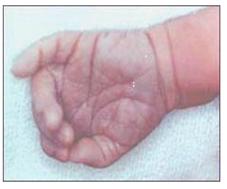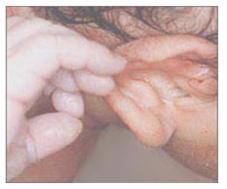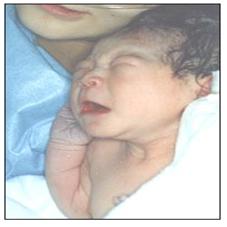신생아 사이아노시스(청색증/자색증/치아노제/시이노제), Cyanosis of newborn infants

사진 61. 선단 청색증(말단 청색증, 첨선 자람증)
빈혈도 없고 심장병도 없는 갓 태어난 아기의 손발이 일시적으로 파랗다.
Copyright ⓒ 2011 John Sangwon Lee, MD., FAAP

사진 62. 왼 손이 선단 청색증으로 파랗다.
아기의 얼굴이 청색증으로 약간 파랗다. 제왕절개 수술분만으로 태어난 아기의 기도가 태변으로 약간 막혀 호흡 곤란이 있었고 산소 결핍증으로 전신 청색증이 잠시 동안 조금 있다가 산소호흡치료를 받고 곧 정상 피부색으로 됐다. 입안의 점막은 파랗지 않은 것을 볼 수 있다.
Copyright ⓒ 2011 John Sangwon Lee, MD., FAAP

사진63. 손에 생긴 선단 청색증(말단 청색증).
제왕절개 수술분만으로 태어난 아기의 손에 선단 청색증이 있고 그 아기의 귀와 얼굴의 피부색은 정상적으로 붉다.
Copyright ⓒ 2011 John Sangwon Lee, MD., FAAP

사진 64. 손에 생긴 선단 청색증(말단 청색증).
제왕절개수술 분만으로 태어난 아기의 손에 선단 청색증이 있고 그 아기의 어깨의 피부색은 정상적으로 붉다.
Copyright ⓒ 2011 John Sangwon Lee, MD., FAAP

사진 65. 제왕절개 수술분만으로 출생한 아기의 손이 파랗고 선단 청색증이 있고 얼굴에 약간의 청색증이 보인다.
Copyright ⓒ 2011 John Sangwon Lee, MD., FAAP

사진 66. 제왕절개 수술분만으로 태어난 아기의 손이 파랗고 얼굴에 약간의 청색증이 보다가 지금은 얼굴색이 붉고 많이 정상으로 돌아갔다.
Copyright ⓒ 2011 John Sangwon Lee, MD., FAAP
- 피부가 파랗게 된 증상징후를 치아노제, 청색증, 사이아노시스, 자색증, 치아노제 또는 자람증이라고 한다.
- 청색증은 중추성 청색증과 선단청색증(말단 청색증)으로 나누어진다.
- 갓 태어난 신생아나 그 이후의 신생아의 입술, 혀, 얼굴, 몸통, 팔다리 등 전신의 피부, 점막층과 몸 전체가 파랗게 된 증상 징후를 전신 사이아노시스, 전신 청색증, 중추성 자람증, 중추성 청색증, 또는 중추성 사이아노시스라고 한다.
- 손이나 발가락 등 신체의 말단 부위에만 생긴 청색증을 선단 청색, 선단 자람증, 말단 청색증, 선단 사이아노시스증, 말초성 청색증, 또는 말초성 사이아노시스증이라고 한다.
- 전신에 생기는 청색증은 체내의 산소 농도가 비정상적으로 상당히 낮을 때 주로 생긴다.
- 심한 호흡기 질환, 심장혈관 질환, 중추신경 이상, 두 개 강 내 출혈, 저 혈당증, 심한 빈혈, 패혈증, 뇌막염 등 생명에 위험한 감염병이 있을 때 중추성 청색증이 생길 수 있다.
- 실내의 온도가 낮을 때 아주 건강한 신생아나 영아의 손발이 파랗게 될 수 있지만 몸 전체가 파랗게 변하지는 않는 것이 보통이다.
- 이때는 중추성 청색증이 있다고 말하지 않고 선단 자람증(先端紫藍症/말단 청색증)이 있다고 말한다.
- 신생이의 손발 등에 선단 청색증이 있을 때는 실내의 온도를 적절히 높이고 몸 전체를 따뜻하게 보온해 주면 금방 선단 청색증이 없어지지만 청색증이 전신에 생겼을 때는 산소 호흡치료를 시키고 그 원인이 되는 병을 치료해야 없어진다.
- 선단 청색증은 정상 신생아들에게 생길 수 있는 정상적인 현상이다.
|
다음은 “뛰면 입술이 새파래지는데…시아노시스, 입술이 새파래지는데, 전신 시아노시스”에 관한 인터넷 소아청소년 건강상담 질의응답의 예 입니다. |
Q&A. 뛰면 입술이 새파래지는데…시아노시스,
입술이 새파래지는데, 전신 시아노시스
Q.
여섯 살 된 여자 아이입니다.아이가 뛰고 나면 입술이 새파래지곤 해서 여쭤봅니다.
천식을 앓은 적이 있어서 소아 청소년과 진료를 받을 때마다 특별히 신경쓰는데 특별히 이상하단 이야기는 들어보지 못했습니다. 입술이 새파래지면 심장 쪽이 안 좋은 것이란 얘기가 있던데 소아 청소년과 에 가서 정밀검사라도 받아봐야 하는 건지요? 궁금해서 여쭤봅니다. 답변 기다리겠습니다.
A.
세영님
안녕하세요. 질문해 주셔서 감사합니다. 좋은 질문입니다.
자녀의 나이, 성별, 과거 병력, 가족 병력, 진찰소견, 임상검사 등의 정보를 많이 알수록 답변을 드리는데 도움이 됩니다. 주신 정보를 토대로 해서 답변을 드리겠습니다.
사이아노시스(Cyanosis)를 시아노제, 치아노제, 청색증, 자색증, 자람증이라고 영한 의학사전에 되어 있습니다.
입술, 입안 점막층, 또는 피부가 창백하거나 파래지는 증상 징후를 사이아노시스라고 합니다.
심혈관 순환기 기능이 원활하지 못하고 체온조절을 잘 못하는 갓 태어난 신생아들, 미숙아들, 신생아들 또는 유약한 영유아들은 주위 온도가 갑자기 상당히 내려가도 입술이 창백하거나 파라질 때가 있습니다.
건강한 소아들의 팔다리를 끈으로 꼭 둘러 맬 때도 꼭 둘러 맨 아래쪽 팔다리 신체부분에 혈액순환이 잘 안 될 수 있고 그 부분가 창백하거나 파래질 수 있습니다. 이것도 일종의 청색증입니다.
이렇게 심장도 정상이고 헤모글로빈 수치도 정상일 때 신체의 일부에만 생기는 청색증(사이아노시스)를 말초 사이아노시스, 또는 말단 청색증이라고 합니다.
이것은 정상 생리 현상의 일종입니다.
말단 청색증은 건강한 아이들 누구에게나 일시적으로 생길 수 있습니다.
그러나 심장에 어떤 이상이 있거나 헤모글로빈이 아주 낮거나 비정상이기 때문에 입술, 입안 점막층, 피부 등 전신이 창백하거나 파래지는 것을 전신 청색증이라고 합니다. 이것은 비정상입니다.
어떤 이유로든 제대로 호흡하지 못해 산소공급이 원활치 못해 체내 산소결핍증이 생기면 헤모글로빈에 붙어 있는 산소 농도가 낮아질 수 있고 다른 어떤 원인으로 인해서 헤모글로빈에 붙어 있는 산소 농도가 정상보다 낮을 때 전신 청색증이 생길 수 있습니다.
적혈구 증가증(Polycythemia), 중추신경 이상, 상기도 폐쇄, 폐포 이상, 폐의 질병, 메트헤모글로빈혈증(Methemoglobinemia) 등으로 전신 청색증이 생길 수 있습니다.
주신 정보로 어떤 종류의 청색증인지 어떤 원인으로 청색증이 생겼는지 알 수 없습니다.
사이아노시스가 심장혈관계 이상으로 생길 때는 심장 내 혈류가 우심장 속에서 좌심장 속으로 비정상적으로 많이 흘러 그 정맥혈이 전신으로 순환될 때 주로 생깁니다.
진찰 상 심장에 이상이 없다고 하셨습니다.
다른 원인을 찾아보시는 것이 좋을 것 같습니다. 청색증. [부모도 반의사가 되어야 한다–소아가정간호백과]-제 11권 소아청소년 심장 혈관계 질환–심 잡음 등을 참조하시기 바랍니다. 소아 청소년과 에서 또 검진 진단을 받고 이 문제에 관해 상담하시기 바랍니다. 질문이 더 있으면 다시 연락해 주시기 바랍니다. 감사합니다. 이상원 드림
Cyanosis of newborn infants 신생아 사이아노시스(청색증/자색증/치아노제/시이노제)

Photo 61. Arocyanosis(Apical cyanosis/terminal cyanosis).
The hands and feet of a newborn baby without anemia and no heart disease are temporarily blue. Copyright ⓒ 2011 John Sangwon Lee, MD., FAAP

Picture 62. The left hand is blue with acrocyanosis.
The baby’s face is cyanotic and slightly blue.
A baby born with a cesarean section was slightly blocked with meconium and had difficulty breathing.
Systemic cyanosis due to oxygen deficiency was shortly followed by oxygen respiration treatment and soon became normal skin color.
You can see that the mucous membrane in the mouth is not blue. Copyright ⓒ 2011 John Sangwon Lee, MD., FAAP

Picture 63. Acrocyanosis in the hand (terminal cyanosis). A baby born with a cesarean section has acrocyanosis on the hand and the skin color of the baby’s ears and face is normally red. Copyright ⓒ 2011 John Sangwon Lee, MD., FAAP

Picture 64. Arocyanosis (terminal cyanosis) on the hand. A baby born with cesarean section delivery has apical cyanosis on the hand and the skin color of the baby’s shoulder is normally red. Copyright ⓒ 2011 John Sangwon Lee, MD., FAAP

Picture 65. A baby born after a cesarean section has blue hands, acrocyanosis, and slight cyanosis on his face. Copyright ⓒ 2011 John Sangwon Lee, MD., FAAP

Picture 66. A baby born with a cesarean section was born with blue hands and a little cyanosis on his face, but now his face is red and has returned to normal. Copyright ⓒ 2011 John Sangwon Lee, MD., FAAP
Symptoms, signs of turning blue skin are called cyanosis, or purpura.
Cyanosis is divided into central cyanosis and acrocyanosis (terminal cyanosis).
The skin, mucous membrane layer, and the entire body, including the lips, tongue, face, torso, and limbs of a newborn baby or a newborn baby, are blue.
Systemic cyanosis,
central purpura, Or it is called central cyanosis.
Cyanosis that occurs only in the distal parts of the body, such as hands or toes, is called peripheral cyanosis(Acrocyanosis).
Systemic cyanosis usually occurs when the oxygen concentration in the body is abnormally low.
Central cyanosis can occur when there is a life-threatening infectious disease such as severe respiratory disease, cardiovascular disease, central nervous system abnormality, intracranial bleeding, hypoglycemia, severe anemia, sepsis, and meningitis.
When the room temperature is low, the hands and feet of a very healthy newborn or infant can become blue, but it is common that the entire body does not turn blue.
At this time, It is not central cyanosis, but it is acrocyanosis(peripheral cyanosis).
When a newborn’s hands and feet have apical cyanosis, raise the indoor temperature appropriately and keep the whole body warm, the tip cyanosis will disappear immediately, but if cyanosis occurs all over the body, oxygen breathing treatment should be given and the disease-causing the disease should be treated. Apical cyanosis is a normal phenomenon that can occur in normal newborns.
The following is an example of a question-and-answer on health counseling for children and adolescents on the Internet about “My lips become blue when I run…Cyanosis, my lips become blue when I run.” Q&A.
My lips turn blue when I run…Cyanosis, My lips are turning blue, and the whole body is cyanosis
Q
I’m a six-year-old girl, and after she runs, her lips turn blue, so I ask.
She has had asthma, so every time she goes to a pediatric and adolescent care, she pays special attention, and I haven’t heard of any particular weird bottom line. It was said that if the lips are dark blue, the heart is bad, but should I go to the Pediatrics and Adolescents for a close examination? I’m curious, so I ask. Answers I’ll wait.
A.
Seyoung Good morning. Thanks for asking. That’s a good question. The more information you know about your child’s age, gender, past medical history, family medical history, medical examination findings, and clinical examination, the more helpful it is to give you an answer. We will respond based on the information you provided.
Cyanosis is described in the English-Korean medical dictionary as 청색증.
Cyanosis is a symptom that the lips, the mucous membrane of the mouth, or the skin becomes pale or blue.
Newborns, premature babies, newborn babies, or weak infants with poor cardiovascular circulatory function and poor body temperature control may have pale or paralyzed lips even when the ambient temperature suddenly drops considerably.
Even when the limbs of healthy children are wrapped tightly with straps, blood circulation to the body part of the lowermost limb may be difficult and the part may become pale or blue.
This is also a type of cyanosis.
When the heart is normal and the hemoglobin level is normal, cyanosis (cyanosis) that occurs only in part of the body is called peripheral cyanosis, or terminal cyanosis.
This is a kind of normal physiological phenomenon. Acromegaly can occur temporarily in any healthy child.
However, because there is something wrong with the heart, or because the hemoglobin is very low or abnormal, the whole body such as the lips, the mucous membrane of the mouth, and the skin becomes pale or blue is called systemic cyanosis.
This is abnormal. If oxygen deficiency occurs in the body due to poor breathing due to poor breathing for any reason, the oxygen concentration attached to hemoglobin may be lowered, and systemic cyanosis may occur when the oxygen concentration attached to hemoglobin is lower than normal due to some other cause.
Systemic cyanosis may occur due to polycythemia, central nervous system abnormalities, upper respiratory tract obstruction, alveolar abnormalities, lung diseases, and methemoglobinemia.
We don’t know what kind of cyanosis or what caused cyanosis based on the information you have given.
When cyanosis is caused by cardiovascular abnormalities, it usually occurs when blood flow in the heart abnormally flows from the right heart to the left heart and the venous blood circulates throughout the body.
On the examination, he said there was no abnormality in the heart. It would be good to look for other causes. Cyanosis.
Visit www.drleepediatrics.com-Volume 11 Children and Adolescent Cardiovascular Diseases-Please refer to heart murmurs You should also go to the Pediatrics and Adolescents Department to get a checkup and talk about this problem. If you have more questions, please contact us again. Thank you. Lee Sang-won, MD
출처 및 참조 문헌 Sources and references
- NelsonTextbook of Pediatrics 22ND Ed
- The Harriet Lane Handbook 22ND Ed
- Growth and development of the children
- Red Book 32nd Ed 2021-2024
- Neonatal Resuscitation, American Academy Pediatrics
- www.drleepediatrics.com 제1권 소아청소년 응급 의료
- www.drleepediatrics.com 제2권 소아청소년 예방
- www.drleepediatrics.com 제3권 소아청소년 성장 발육 육아
- www.drleepediatrics.com 제4권 모유,모유수유, 이유
- www.drleepediatrics.com 제5권 인공영양, 우유, 이유식, 비타민, 미네랄, 단백질, 탄수화물, 지방
- www.drleepediatrics.com 제6권 신생아 성장 발육 육아 질병
- www.drleepediatrics.com제7권 소아청소년 감염병
- www.drleepediatrics.com제8권 소아청소년 호흡기 질환
- www.drleepediatrics.com제9권 소아청소년 소화기 질환
- www.drleepediatrics.com제10권. 소아청소년 신장 비뇨 생식기 질환
- www.drleepediatrics.com제11권. 소아청소년 심장 혈관계 질환
- www.drleepediatrics.com제12권. 소아청소년 신경 정신 질환, 행동 수면 문제
- www.drleepediatrics.com제13권. 소아청소년 혈액, 림프, 종양 질환
- www.drleepediatrics.com제14권. 소아청소년 내분비, 유전, 염색체, 대사, 희귀병
- www.drleepediatrics.com제15권. 소아청소년 알레르기, 자가 면역질환
- www.drleepediatrics.com제16권. 소아청소년 정형외과 질환
- www.drleepediatrics.com제17권. 소아청소년 피부 질환
- www.drleepediatrics.com제18권. 소아청소년 이비인후(귀 코 인두 후두) 질환
- www.drleepediatrics.com제19권. 소아청소년 안과 (눈)질환
- www.drleepediatrics.com 제20권 소아청소년 이 (치아)질환
- www.drleepediatrics.com 제21권 소아청소년 가정 학교 간호
- www.drleepediatrics.com 제22권 아들 딸 이렇게 사랑해 키우세요
- www.drleepediatrics.com 제23권 사춘기 아이들의 성장 발육 질병
- www.drleepediatrics.com 제24권 소아청소년 성교육
- www.drleepediatrics.com 제25권 임신, 분만, 출산, 신생아 돌보기
- Red book 29th-31st edition 2021
- Nelson Text Book of Pediatrics 19th- 21st Edition
- The Johns Hopkins Hospital, The Harriet Lane Handbook, 22nd edition
- 응급환자관리 정담미디어
- Pediatric Nutritional Handbook American Academy of Pediatrics
- 소아가정간호백과–부모도 반의사가 되어야 한다, 이상원 저
- The pregnancy Bible. By Joan stone, MD. Keith Eddleman, MD
- Neonatology Jeffrey J. Pomerance, C. Joan Richardson
- Preparation for Birth. Beverly Savage and Dianna Smith
- 임신에서 신생아 돌보기까지. 이상원
- Breastfeeding. by Ruth Lawrence and Robert Lawrence
- Sources and references on Growth, Development, Cares, and Diseases of Newborn Infants
- Emergency Medical Service for Children, By Ross Lab. May 1989. p.10
- Emergency care, Harvey Grant and Robert Murray
- Emergency Care Transportation of Sick and Injured American Academy of Orthopaedic Surgeons
- Emergency Pediatrics A Guide to Ambulatory Care, Roger M. Barkin, Peter Rosen
- Quick Reference To Pediatric Emergencies, Delmer J. Pascoe, M.D., Moses Grossman, M.D. with 26 contributors
- Neonatal resuscitation Ameican academy of pediatrics
- Pediatric Nutritional Handbook American Academy of Pediatrics
- Pediatric Resuscitation Pediatric Clinics of North America, Stephen M. Schexnayder, M.D.
-
Pediatric Critical Care, Pediatric Clinics of North America, James P. Orlowski, M.D.
-
Preparation for Birth. Beverly Savage and Dianna Smith
-
Infectious disease of children, Saul Krugman, Samuel L Katz, Ann A.
- 제4권 모유, 모유수유, 이유 참조문헌 및 출처
- 제5권 인공영양, 우유, 이유, 비타민, 단백질, 지방 탄수 화물 참조문헌 및 출처
- 제6권 신생아 성장발육 양호 질병 참조문헌 및 출처
- 소아과학 대한교과서
Copyright ⓒ 2014 John Sangwon Lee, MD., FAAP
“부모도 반의사가 되어야 한다”-내용은 여러분들의 의사로부터 얻은 정보와 진료를 대신할 수 없습니다.
“The information contained in this publication should not be used as a substitute for the medical care and advice of your doctor. There may be variations in treatment that your doctor may recommend based on individual facts and circumstances.
“Parental education is the best medicine.